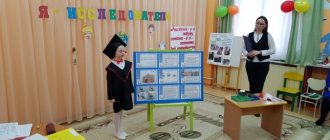The subject world of preschoolers
Anastasia Samsonova
The subject world of preschoolers
The formation of preschoolers’ ideas about the objective world covers all aspects of the educational process and is significant and relevant. Cognitive interest in the objective world , having powerful incentive and regulatory capabilities, contributes to the effective development of the child as a subject of cognitive activity.
This active cognitive attitude towards reality must be formed from childhood.
The objective world has a great influence on the emerging needs of a little person and serves as a kind of support for him in communicating with other people. Through the object, the baby learns that the world has different properties and qualities: it is warm, and cold, and rough, and smooth, and sweet, and salty. The child masters ways of acting with objects , and this helps him acquire “power”
over the world in which he lives.
This circumstance gives rise to a feeling of confidence, calmness and a desire to explore the world. The subject introduces the child into the world of adults, “informs”
him about this world, enriches the content of social experience and influences all-round development.
Any subject contains social experience and reflects the level of development of society and technological progress. The objects materialize the centuries-old experience of mankind, which appears before the child in a generalized form, revealed in physical and dynamic properties, qualities and relationships.
A means of introducing children to their native land can be objects of the man-made world , with which the child constantly acts or which he sees in his immediate environment.
Familiarization with the objective world has several directions inextricably linked with local history.
The content of knowledge about the hometown was conditionally divided into three blocks: the natural world, human activities (work, everyday life, holidays)
and the cultural appearance of the hometown (architecture, monuments, industry, folk crafts, personifying
the objective world on a larger scale.
The transformative activity of adults, their creativity is clearly presented in how the same object depending on people’s needs for it. Modification objective world is manifested in the creation of multifunctionality of objects , i.e. a person gives different functions to one form, facilitating the use of objects .
Children's ideas about the past , present and future of objects allow the child to see the world around him in dynamics, temporary movement and development. In addition, turning to the past is one of the means of self-knowledge, determining one’s place in the world and in time (past - present - future), one’s value orientations.
The didactic potential of local history knowledge can be divided into:
1) a description of the previous social experience of man and humanity in the endless diversity and dynamics of relationships, views, activities, in the multidimensionality and mobility of historical time and space;
2) an explanation that gives the child, in the categories and methods of historical analysis, a tool for comprehending the world and himself in the world - from the past through the present to the future.
objects surrounding a child should arouse in him curiosity, keen interest, a desire to enter this world, transform it, improve it, and for this, by the end of preschool age the child must have a sufficient supply of ideas about the history of the creation and change of objects by man . The need for historical knowledge for the development of a perspective view of surrounding objects was noted by Aristotle, putting forward the idea that without understanding the past we cannot understand the present.
The subject environment is of great importance in a child’s life: being the first object of a preschooler’s , it also becomes one of the first objects of knowledge of the surrounding reality. The environment should be organized in such a way that the child has a wide choice of various types of activities (playing, communicative, cognitive-research, design, perception of fiction and folklore, artistic-aesthetic, musical, motor, labor) together with peers and individually.
The developing subject-spatial environment of our group is saturated with local history content. The group has created a center for local history, which contains dolls in national costumes, the flag and coat of arms of Russia, a photograph of our president V.V. Putin, the coat of arms of our hometown, and photographs of our kindergarten. As a result of joint work with parents, family photo albums were created.
Albums about birds and animals of our region, albums about plants of our region, album “Sights of our city”
were made by children and their parents, as well as together with teachers.
preschool can be solved most effectively These are games such as the walking game “City Trip”
, cut-out pictures,
“Who works for whom?”
,
“Find the tree” “Which flower?”
,
"Guess a riddle"
.
Also, together with parents, “Collect a picture”
with the sights of Arzamas were created. Games of a local history nature help children develop various skills and abilities: orientation in space, development of logical and associative thinking, consolidation of arithmetic calculation, and search for an independent solution.
The centers have a small library of collections of poems about the city and a variety of educational literature about the Nizhny Novgorod region.
In the local history center of the group there is a laptop dedicated to our city. It was made through the joint efforts of children, parents and educators.
The local history content of the developing subject-spatial environment is not limited only to the local history corner.
At the center of creativity are albums with samples of paintings, folk toys, reproductions of paintings by famous artists of their region, as well as the necessary material for independent work; folk costumes for children, masks for acting out scenes from folklore, nursery rhymes, folk songs; folk musical instruments, as well as musical material (lullabies, folk songs)
.
The physical development center contains information about athletes who glorified their native land with their achievements in sports, and attributes for folk outdoor games.
At the center of cognitive development are: mini-laboratories with the necessary equipment and materials for conducting experiments, samples of minerals from our native land, herbariums of plants growing in our region, albums and books with illustrations of plants and animals, as well as those listed in the Red Book ; in the construction corner there are diagrams and models of city buildings familiar to children and the necessary building material for independent construction.
The game center presents material for role-playing games. Using the example of stories of dishes , furniture, clothing, toiletries, etc., I expand children’s ideas about what these things looked like in the distant past, how a person, satisfying his needs, invented, transformed and improved objects for his needs , and ideas borrowed from nature.
One of the effective means of forming ideas about the child’s objective world can be a museum in a preschool institution . A museum is capable of enriching a child with impressions of completely new, unfamiliar objects that he has never met, and could not meet in reality accessible to him. This unusually broadens one’s horizons and understanding of the world , which is why modern parents strive to introduce their children to the museum as early as possible. It has been noted that a child learns material better if conditions are created in which he enriches his experience through touch and actions with previously unfamiliar objects .
In one of the groups of our garden there is a museum “Russian Izba”
.
Museum exhibits help children get an idea of the material and spiritual life of their people, their traditions, and awaken interest in research activities. It contains such exhibits as: elements of Russian folk costume (kokoshniks, shirts, scarves, skirts, household items (knitted floorboards, baskets , towels)
and utensils
(samovar, wooden dishes)
of the Russian hut, folk toys (straw toys, nesting dolls, amulets, Russian folk musical instruments
(balalaika, whistles, pipes, spoons)
. In it, children can completely immerse themselves in the world of their
ancestors . This helps children gain an understanding of the material and spiritual life of their people, their traditions, and awaken interest in research activities.
Any object in the man-made world contains the social experience of humanity, reflects the level of development of society. The object world has a great influence on the emerging needs of a small person, serves as a unique support in communication with other people. This is why objects of the man-made world are so important in the process of socialization. They provide the child with this opportunity due to their characteristics, such as shape, size, color, material, structure, function, purpose, creation and transformation, that is, characteristics that are amenable to change in the process of human activity. By mastering the understanding of the retrospective of the material environment, the child realizes that a person purposefully changes objects , making them more convenient and useful.
a special place in the objective world for a child. It is also a means for him to become familiar with the social world. Through a toy, a child learns the diversity of life in its properties and qualities. A technical toy helps a child get acquainted with the achievements of technical thought, with methods of controlling objects , and gives an idea of a person’s ability to influence the world around him. A story-driven toy enriches understanding of the world of adults and their activities. A folk toy helps to introduce a child to his national roots, to his people. Thus, objects and toys serve as a means of introducing children to social reality, allowing them to expand their understanding of the world .
objects surrounding a child should arouse in him curiosity, keen interest, a desire to enter this world, transform it, improve it, and for this, by the end of preschool age the child must have a sufficient supply of ideas about the history of the creation and change of objects by man .
From an early age, one must not only learn to distinguish and group things according to their purpose and characteristics, but also learn to value a thing according to the work that has been put into it. When people create things, they not only think about their direct use, but also strive to make them beautiful, sometimes like genuine objects of art . Children from an early age need to be taught to see the beauty of color, shape, and their combination in things. The aesthetic perception of a thing is of very great value. From an early age, a child needs to develop taste and the ability to surround himself with things that bring joy and aesthetic pleasure. Then things become a person’s friends, they are protected.





